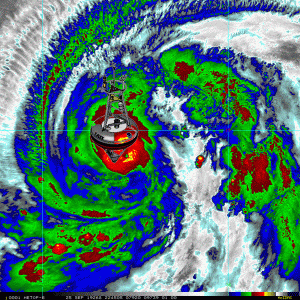Hurricane Lorenzo Passes Directly Over PIRATA Mooring
 On Thursday, September 26, 2019, Hurricane Lorenzo tracked directly over the PIRATA T-Flex mooring at 15°N, 38°W. Despite the direct hit, the mooring remains in position and continues to transmit high-quality, high-resolution data in real-time. Refer to the image which shows the approximate location of the PIRATA mooring superimposed over the Enhanced Infrared (IR) Imagery (1 km Mercator, from MODIS/AVHRR) of Hurricane Lorenzo immediately prior to passing over the PIRATA mooring.
On Thursday, September 26, 2019, Hurricane Lorenzo tracked directly over the PIRATA T-Flex mooring at 15°N, 38°W. Despite the direct hit, the mooring remains in position and continues to transmit high-quality, high-resolution data in real-time. Refer to the image which shows the approximate location of the PIRATA mooring superimposed over the Enhanced Infrared (IR) Imagery (1 km Mercator, from MODIS/AVHRR) of Hurricane Lorenzo immediately prior to passing over the PIRATA mooring.
Data collected from the Global Tropical Moored Buoy Array helps us understand changes in the ocean and improve our forecasts and predictions of marine events. Data plots included here (refer to image below) illustrate the oceanic and atmospheric changes during a hurricane, most notably one can see the barometric pressure drops dramatically.
T-Flex (or “Tropical Flex”) moorings are a newer generation of moorings that were developed at PMEL to replace the legacy ATLAS mooring technology. T-Flex incorporates new or updated commercially available sensors and uses Iridium for telemetry of higher temporal resolution data. This is particularly advantageous for observing natural phenomena that occur over short time scales, such as the passing of a hurricane. Unlike ATLAS moorings, T-Flex moorings transmit high-res data in real-time, meaning we do not need to wait a year to recover the mooring before we can take advantage of using the data. Both the PIRATA and RAMA moored buoy arrays are in the process of transitioning to T-Flex moorings.